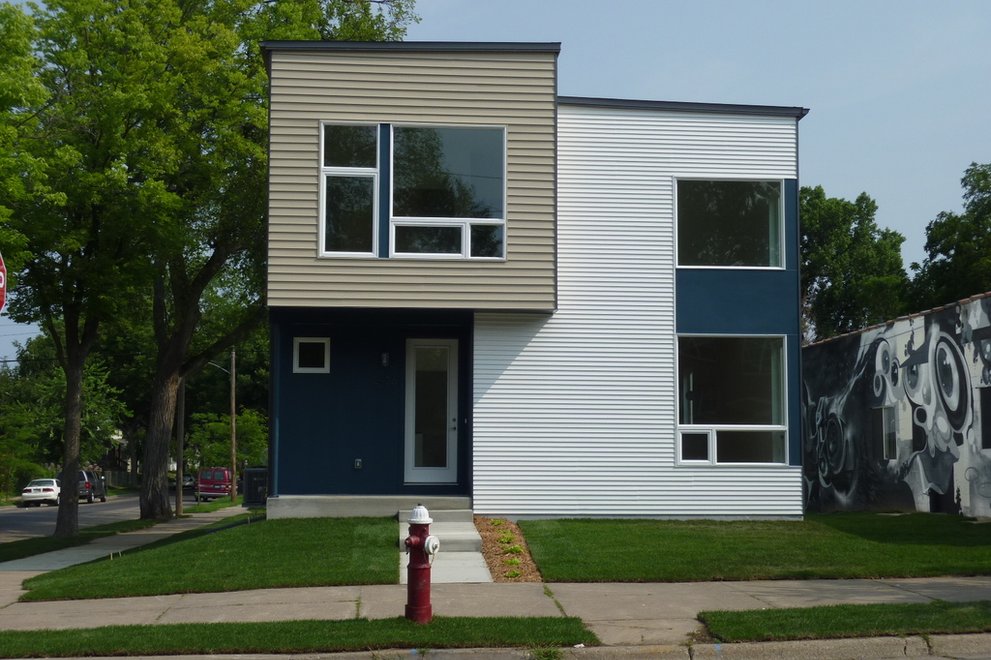Fiber cement siding, as shown in Plan 909-2 above, looks
like wood but has a number of significant advantages. It is largely made from eco friendly materials including recycled wood fiber and fly ash (which is repurposed industrial waste from coal combustion), and cement, and has a very low water content. In general, fiber cement has so little cellulose content that termites and other insects have little interest in it. And it absorbs so little water that it is very resistant to rot and mold. Most importantly, it's resistant to fire: the thicker the boards, the higher the fire rating.
Fiber cement products match the shape and texture of shiplap, board-and-batten, cedar shingles, V-groove, and most other wood siding. Trim, moulding, soffits, and even specialty pieces are available. You can get brick mold, crown molding and everything in between. It's possible to weave shingles, say, around the corner for an uninterrupted surface (without corner boards). Some higher end brands can be milled or routed just like wood trim. Fiber cement boards are also available as sheets for homes with a modern aesthetic, and in forms that match asbestos shingles. It is so realistic that it has been approved to replace wood siding in a number of historic districts. The realistic look is because fiber cement is made from molds created with actual wood siding.
Much more moisture resistant than stucco, fiber cement requires far fewer repairs over time. Paint also adheres to it better and reduces maintenance costs. However installation tends to cost more because the material is much heavier than wood. It also needs to be cut with a special mask to protect workers from the resulting dust. Fiber cement boards come pre-primed and in many cases a variety of paint colors are available.
Cost varies according to thickness and manufacturer. Regular 5/16-inch fiberboard costs around $1.35 per linear foot and a 3/4-inch series costs around $2.90 per linear foot. By comparison redwood or cedar siding costs around $1.75 per linear foot. Vinyl siding is cheaper than any of these but is environmentally unfriendly and lacks an authentic look. An alternative to fiber cement or vinyl for siding is engineered wood, such as LP SmartSide and Collins TrueWood.
Manufacturers
Allura. 22 colors and six stains.
Boral TrueExterior Siding and Trim. Very high quality because it is made from fly ash rather than Portland
cement and is totally impervious to water. Boral’s siding maintains a high level of dimensional stability during changes in temperature and humidity and can be mitered or milled to any shape.
GAF Weatherside. Manufactured to look like the many shapes of existing asbestos shingle
siding but now without the asbestos.
James Hardie. HardiePlank is the standard Hardie product. 5/16 inch-thick by 12 foot-long lap siding, in
widths ranging from 5 1/4 inches to 8 ¼ inches and extremely realistic patterns and textures.
Nichiha. From Japan and known for commercial grade siding, their Nichiboard is designed
for a range of residential siding applications.
David Jacknin is a contractor based in the San Francisco Bay Area.
Fiber cement products match the shape and texture of shiplap, board-and-batten, cedar shingles, V-groove, and most other wood siding. Trim, moulding, soffits, and even specialty pieces are available. You can get brick mold, crown molding and everything in between. It's possible to weave shingles, say, around the corner for an uninterrupted surface (without corner boards). Some higher end brands can be milled or routed just like wood trim. Fiber cement boards are also available as sheets for homes with a modern aesthetic, and in forms that match asbestos shingles. It is so realistic that it has been approved to replace wood siding in a number of historic districts. The realistic look is because fiber cement is made from molds created with actual wood siding.
Much more moisture resistant than stucco, fiber cement requires far fewer repairs over time. Paint also adheres to it better and reduces maintenance costs. However installation tends to cost more because the material is much heavier than wood. It also needs to be cut with a special mask to protect workers from the resulting dust. Fiber cement boards come pre-primed and in many cases a variety of paint colors are available.
Cost varies according to thickness and manufacturer. Regular 5/16-inch fiberboard costs around $1.35 per linear foot and a 3/4-inch series costs around $2.90 per linear foot. By comparison redwood or cedar siding costs around $1.75 per linear foot. Vinyl siding is cheaper than any of these but is environmentally unfriendly and lacks an authentic look. An alternative to fiber cement or vinyl for siding is engineered wood, such as LP SmartSide and Collins TrueWood.
Manufacturers
Allura. 22 colors and six stains.
Boral TrueExterior Siding and Trim. Very high quality because it is made from fly ash rather than Portland
cement and is totally impervious to water. Boral’s siding maintains a high level of dimensional stability during changes in temperature and humidity and can be mitered or milled to any shape.
GAF Weatherside. Manufactured to look like the many shapes of existing asbestos shingle
siding but now without the asbestos.
James Hardie. HardiePlank is the standard Hardie product. 5/16 inch-thick by 12 foot-long lap siding, in
widths ranging from 5 1/4 inches to 8 ¼ inches and extremely realistic patterns and textures.
Nichiha. From Japan and known for commercial grade siding, their Nichiboard is designed
for a range of residential siding applications.
David Jacknin is a contractor based in the San Francisco Bay Area.






